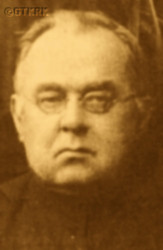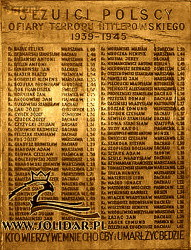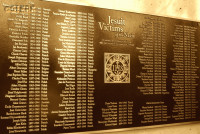Roman Catholic
St Sigismund parish
05-507 Słomczyn
85 Wiślana Str.
Konstancin deanery
Warsaw archdiocese, Poland
full list:
displayClick to display full list

searchClick to search full list by categories
wyświetlKliknij by wyświetlić pełną listę po polsku

szukajKliknij by przeszukać listę wg kategorii po polsku

Martyrology of the clergy — Poland
XX century (1914 – 1989)
personal data
surname
JABŁOŃSKI
surname
versions/aliases
FIJAŁEK
forename(s)
Blase (pl. Błażej)
function
religious cleric
creed
Latin (Roman Catholic) Church RCmore on
en.wikipedia.org
[access: 2014.09.21]
congregation
Society of Jesus SImore on
en.wikipedia.org
[access: 2014.09.21]
(i.e. Jesuits)
diocese / province
Greater Poland‐Mazovian province SI
Polish Province SI (1918‐1926)
Galicia Province SI (till 1918)
date and place
of death
11.12.1942

Pagryžuvystoday: Tytuvėnai eld., Kelmė dist., Šiauliai Cou., Lithuania
more on
lt.wikipedia.org
[access: 2022.06.29]
details of death
After German and Russian invasion of Poland in 09.1939 and start of the World War II, after start of Russian occupation apprehended by Russians and put to the firing squad — saved by a Jew whom he supported financially.
Later arrested by the Russians and jailed in a basement of Pinsk magistrate.
Released after three days.
Left Pinsk and moved to Vilnius (then possibly still under Lithuanian occupation, prior to Russian occupation that started in 06.1940.
Settled in local Jesuit monastery.
After German attack on 22.06.1941 of their erstwhile ally, Russians, arrested by the Germans on 26.03.1942.
Jailed in Lukiškės prison in Vilnius.
Next on 08.06.1942 moved to Pogryżów internment camp, where perished.
cause of death
extermination
perpetrators
Germans
sites and events
Vilnius (Lukiškės)Click to display the description, 03.03.1942 arrests (Vilnius)Click to display the description, Ribbentrop‐MolotovClick to display the description, Pius XI's encyclicalsClick to display the description
date and place
of birth
21.01.1871

Przeworsktoday: Przeworsk urban gm., Przeworsk pov., Subcarpathia voiv., Poland
more on
en.wikipedia.org
[access: 2021.10.09]
religious vows
02.02.1903 (last)
presbyter (holy orders)
ordination
07.07.1900

Khyrivtoday: Khyriv urban hrom., Sambir rai., Lviv obl., Ukraine
more on
en.wikipedia.org
[access: 2021.10.09]
positions held
c. 1940 – 1942
friar — Vilniustoday: Vilnius city dist., Vilnius Cou., Lithuania
more on
en.wikipedia.org
[access: 2022.01.06] ⋄ St Casimir the Prince and Confessor monastery, Jesuits SI
1937 – 1939
administrator — Pinsktoday: Pinsk city dist., Brest reg., Belarus
more on
en.wikipedia.org
[access: 2022.07.16] ⋄ St Stanislav the Bishop and Martyr monastery, Jesuits SI
1928 – 1937
treasury officer / procurator — Greater Poland–Mazovian Province, Jesuits SI
1927 – 1928
administrator — Lublintoday: Lublin city pov., Lublin voiv., Poland
more on
en.wikipedia.org
[access: 2021.08.20] ⋄ St Peter the Apostle monastery, Jesuits SI
1924 – 1927
treasury officer / procurator — Greater Poland–Mazovian Province, Jesuits SI
1925 – 1926
administrator — Warsawtoday: Warsaw city pov., Masovia voiv., Poland
more on
en.wikipedia.org
[access: 2021.10.09] ⋄ Our Lady the Gracious monastery (at 10/12 Świętojańska Str.), Jesuits SI
1921 – 1924
treasury officer / procurator — Krakówtoday: Kraków city pov., Lesser Poland voiv., Poland
more on
en.wikipedia.org
[access: 2021.06.07] ⋄ Jesuit Fathers' Publishing House, College (Lat. Collegium Maximum SS. Cordis Iesu, 26 Kopernik Str.), Jesuits SI
1914 – 1919
administrator — Stara Wieśtoday: Brzozów gm., Brzozów pov., Subcarpathia voiv., Poland
more on
en.wikipedia.org
[access: 2021.12.18] ⋄ Assumption of the Blessed Virgin Mary monastery, Jesuits SI
1905 – 1914
administrator — Bunkovychin .Khyriv
today: Khyriv urban hrom., Sambir rai., Lviv obl., Ukraine
more on
uk.wikipedia.org
[access: 2022.11.09] ⋄ St Joseph College („Khyriv” Scientific and Educational Institute), Jesuits SI
1901 – 1905
educator — Bunkovychin .Khyriv
today: Khyriv urban hrom., Sambir rai., Lviv obl., Ukraine
more on
uk.wikipedia.org
[access: 2022.11.09] ⋄ St Joseph College („Khyriv” Scientific and Educational Institute), Jesuits SI
1898 – 1900
student — Krakówtoday: Kraków city pov., Lesser Poland voiv., Poland
more on
en.wikipedia.org
[access: 2021.06.07] ⋄ theology, College (Lat. Collegium Maximum SS. Cordis Iesu, 26 Kopernik Str.), Jesuits SI
1894
educator — Bunkovychin .Khyriv
today: Khyriv urban hrom., Sambir rai., Lviv obl., Ukraine
more on
uk.wikipedia.org
[access: 2022.11.09] ⋄ St Joseph College („Khyriv” Scientific and Educational Institute), Jesuits SI — also: teacher of calligraphy
1893 – 1894
student — Ternopiltoday: Ternopil urban hrom., Ternopil rai., Ternopil obl., Ukraine
more on
en.wikipedia.org
[access: 2020.11.20] ⋄ philosophy, College, Jesuits SI
24.09.1888
accession — Stara Wieśtoday: Brzozów gm., Brzozów pov., Subcarpathia voiv., Poland
more on
en.wikipedia.org
[access: 2021.12.18] ⋄ Assumption of the Blessed Virgin Mary monastery, Jesuits SI
sites and events
descriptions
Vilnius (Lukiškės): Vilnius prison used both by Russians and Germans. Thousands of Poles were kept there. From 2,000 to 16,000 prisoners were jailed at any time there. In 06.1941, after German invasion, Russians murdered most of the prisoners. (more on: en.wikipedia.orgClick to attempt to display webpage
[access: 2021.07.04])
03.03.1942 arrests (Vilnius): On 03.03.1942 in Vilnius Germans arrested 28 professors and 81 seminarians of Vilnius Theological Seminary, prob. denounced by the Lithuanians. A few weeks later, on 26.03.1942, the Germans and the Lithuanians who collaborated with them arrested 9 religious fathers, 5 brothers, 2 novices and 1 boy helping in the kitchen, from the Jesuit College of Vilnius. All were locked in Lukiškės prison in Vilnius. Professors were on 18.03.1942 transported to Wyłkowyszki and interned there. In 10.1942 were subsequently sent to concentration camp (i.e. Szałtupie, IL Panevėžiukas). The seminarians were transported out on 04.05.1942 to Germany for slave labour (most of them escaped during the transport). Theological seminary was closed. Few weeks after Vilnius seminary arrests, on 26.03.1942 Germans arrested Vilnius religious friars and clerics (Jesuits and Missionary Fathers of St Vincent a Pauli, among others) who got exposed to the same prison treatment. (more on: www.tygodnik.ltClick to attempt to display webpage
[access: 2013.05.19])
Ribbentrop‐Molotov: Genocidal Russian‐German alliance pact between Russian leader Joseph Stalin and German leader Adolf Hitler signed on 23.08.1939 in Moscow by respective foreign ministers, Mr. Vyacheslav Molotov for Russia and Joachim von Ribbentrop for Germany. The pact sanctioned and was the direct cause of joint Russian and German invasion of Poland and the outbreak of the World War II in 09.1939. In a political sense, the pact was an attempt to restore the status quo ante before 1914, with one exception, namely the „commercial” exchange of the so‐called „Kingdom of Poland”, which in 1914 was part of the Russian Empire, fore Eastern Galicia (today's western Ukraine), in 1914 belonging to the Austro‐Hungarian Empire. Galicia, including Lviv, was to be taken over by the Russians, the „Kingdom of Poland” — under the name of the General Governorate — Germany. The resultant „war was one of the greatest calamities and dramas of humanity in history, for two atheistic and anti‐Christian ideologies — national and international socialism — rejected God and His fifth Decalogue commandment: Thou shall not kill!” (Abp Stanislav Gądecki, 01.09.2019). The decisions taken — backed up by the betrayal of the formal allies of Poland, France and Germany, which on 12.09.1939, at a joint conference in Abbeville, decided not to provide aid to attacked Poland and not to take military action against Germany (a clear breach of treaty obligations with Poland) — were on 28.09.1939 slightly altered and made more precise when a treaty on „German‐Russian boundaries and friendship” was agreed by the same murderous signatories. One of its findings was establishment of spheres of influence in Central and Eastern Europe and in consequence IV partition of Poland. In one of its secret annexes agreed, that: „the Signatories will not tolerate on its respective territories any Polish propaganda that affects the territory of the other Side. On their respective territories they will suppress all such propaganda and inform each other of the measures taken to accomplish it”. The agreements resulted in a series of meeting between two genocidal organization representing both sides — German Gestapo and Russian NKVD when coordination of efforts to exterminate Polish intelligentsia and Polish leading classes (in Germany called «Intelligenzaktion», in Russia took the form of Katyń massacres) where discussed. Resulted in deaths of hundreds of thousands of Polish intelligentsia, including thousands of priests presented here, and tens of millions of ordinary people,. The results of this Russian‐German pact lasted till 1989 and are still in evidence even today. (more on: en.wikipedia.orgClick to attempt to display webpage
[access: 2015.09.30])
Pius XI's encyclicals: Facing the creation of two totalitarian systems in Europe, which seemed to compete with each other, though there were more similarities than contradictions between them, Pope Pius XI issued in 03.1937 (within 5 days) two encyclicals. In the „Mit brennender Sorge” (Eng. „With Burning Concern”) published on 14.03.1938, condemned the national socialism prevailing in Germany. The Pope wrote: „Whoever, following the old Germanic‐pre‐Christian beliefs, puts various impersonal fate in the place of a personal God, denies the wisdom of God and Providence […], whoever exalts earthly values: race or nation, or state, or state system, representatives of state power or other fundamental values of human society, […] and makes them the highest standard of all values, including religious ones, and idolizes them, this one […] is far from true faith in God and from a worldview corresponding to such faith”. On 19.03.1937, published „Divini Redemptoris” (Eng. „Divine Redeemer”), in which criticized Russian communism, dialectical materialism and the class struggle theory. The Pope wrote: „Communism deprives man of freedom, and therefore the spiritual basis of all life norms. It deprives the human person of all his dignity and any moral support with which he could resist the onslaught of blind passions […] This is the new gospel that Bolshevik and godless communism preaches as a message of salvation and redemption of humanity”… Pius XI demanded that the established human law be subjected to the natural law of God , recommended the implementation of the ideal of a Christian state and society, and called on Catholics to resist. Two years later, National Socialist Germany and Communist Russia came together and started World War II. (more on: www.vatican.vaClick to attempt to display webpage
[access: 2023.05.28], www.vatican.vaClick to attempt to display webpage
[access: 2023.05.28])
sources
personal:
college.holycross.eduClick to attempt to display webpage
[access: 2012.11.23], www.bj.uj.edu.plClick to attempt to display webpage
[access: 2012.11.23], inpersonachristiadmajoremdeigloriam.blogspot.comClick to attempt to display webpage
[access: 2013.08.17], archive.todayClick to attempt to display webpage
[access: 2021.12.19]
bibliographical:
„Martyrology of the Polish Roman Catholic clergy under nazi occupation in 1939‐1945”, Victor Jacewicz, John Woś, vol. I‐V, Warsaw Theological Academy, 1977‐1981
„Vilnius archdiocese clergy martyrology 1939‐1945”, Fr Thaddeus Krahel, Białystok, 2017
„Jesuits on Polish and Lithuanian territory knowledge encyclopedia, 1564‐1995”, Fr Louis Grzebień SI (editor), WAM Printing House, Cracow 1996
original images:
www.sowiniec.com.plClick to attempt to display webpage
[access: 2016.03.14], college.holycross.eduClick to attempt to display webpage
[access: 2013.05.19]
LETTER to CUSTODIAN/ADMINISTRATOR
If you have an Email client on your communicator/computer — such as Mozilla Thunderbird, Windows Mail or Microsoft Outlook, described at WikipediaPatrz:
en.wikipedia.org, among others — try the link below, please:
LETTER to CUSTODIAN/ADMINISTRATORClick and try to call your own Email client
If however you do not run such a client or the above link is not active please send an email to the Custodian/Administrator using your account — in your customary email/correspondence engine — at the following address:

giving the following as the subject:
MARTYROLOGY: JABŁOŃSKI Blase
To return to the biography press below:
 Click to return to biography
Click to return to biography










